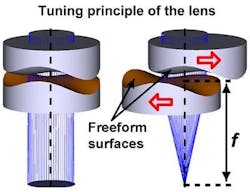Compact endoscope with freeform optics makes colonoscopies more comfortable
Researchers from the National University of Singapore have created an endoscopic probe containing optics that have two opposing freeform surfaces; the probe delivers adjustable-focus capabilities in a package that is significantly smaller than that of conventional endoscopic probes.1 As a result, the dreaded colonoscopy—a routine cancer-screening procedure that has such a reputation for discomfort that it has become the butt of many jokes—could become less uncomfortable.
Existing endoscopes that try to surmount the discomfort problem by optically zooming, thus reducing the need to physically move the camera; however, these devices tend to be bulky. The new endoscope has an extremely compact optical arrangement consisting of two transparent polymer plates, each with one flat surface and one freeform curved surface. The freeform surfaces are inverses of each other; when the transparent plates are perfectly aligned with the freeform surfaces facing each other, they behave as one unit without any focusing power. However, when they are slightly offset in a sideways direction, they focus light as would a conventional lens. Two piezoelectric benders drive these minute shifts in lens placement, controlling the focusing power of the endoscope by changing the degree of displacement. The image is then transmitted to an external camera monitored by a technician.
Large focus range
The lens has a focus range of 135 to 205 diopters, can image objects from 20 to 150 mm away, and has a resolution of about 30 line pairs per millimeter. The optical system's two freeform surfaces are governed by sixth-degree polynomials.
The resulting device is far less bulky than existing high-magnification endoscopes. Although some labs are testing an alternative approach to reducing the size of endoscopes by making them with tunable liquid-crystal lenses, those lenses can be fragile and difficult to handle, according to the research team. Their new design, they said, uses only solid components.
"It is the first time, to our knowledge, that a solid electrically-tunable lens is implemented in an endoscopic system for the purpose of focus tuning," says Guangya Zhou, a researcher at National University of Singapore who led the project.
Their device is still in the early stages and has not yet been tested in a clinical setting. The next step will be to incorporate multiple tunable lenses into the system so that it has not just adjustable focus, but full-fledged optical zooming capabilities as well.
"Once successful, the miniature optical zoom endoscope with autofocus capability may allow doctors to switch conveniently from a wide field-of-view to a clear high-resolution close-up view without moving the endoscope probe," says Zhou. "This may not only reduce the complexity of the endoscopic procedure but also allow potentially high-magnification endoscopy."
In some cases, he says, high-resolution imaging might provide enough information about the tissue to eliminate the need for an invasive biopsy.
Source: OSA
REFERENCE:
1. Y. Zou et al., Optics Express 23 (2015); doi: 10.1364/OE.23.020582
About the Author
John Wallace
Senior Technical Editor (1998-2022)
John Wallace was with Laser Focus World for nearly 25 years, retiring in late June 2022. He obtained a bachelor's degree in mechanical engineering and physics at Rutgers University and a master's in optical engineering at the University of Rochester. Before becoming an editor, John worked as an engineer at RCA, Exxon, Eastman Kodak, and GCA Corporation.

